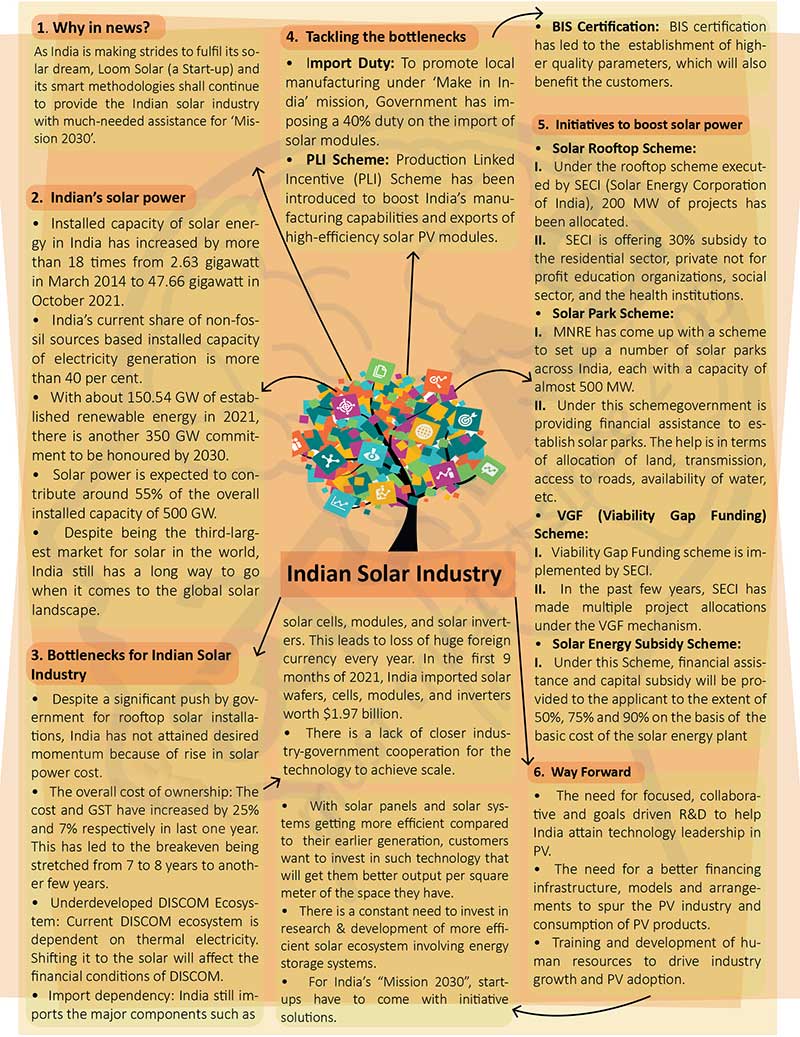Brain-booster /
20 Feb 2022
Brain Booster for UPSC & State PCS Examination (Topic: Indian Solar Industry)

Why in news?
- As India is making strides to fulfil its solar dream, Loom Solar (a
Start-up) and its smart methodologies shall continue to provide the Indian
solar industry with much-needed assistance for ‘Mission 2030’.
Indian’s solar power
- Installed capacity of solar energy in India has increased by more than
18 times from 2.63 gigawatt in March 2014 to 47.66 gigawatt in October 2021.
- India’s current share of non-fossil sources based installed capacity of
electricity generation is more than 40 per cent.
- With about 150.54 GW of established renewable energy in 2021, there is
another 350 GW commitment to be honoured by 2030.
- Solar power is expected to contribute around 55% of the overall
installed capacity of 500 GW.
- Despite being the third-largest market for solar in the world, India
still has a long way to go when it comes to the global solar landscape.
Bottlenecks for Indian Solar Industry
- Despite a significant push by government for rooftop solar
installations, India has not attained desired momentum because of rise in
solar power cost.
- The overall cost of ownership: The cost and GST have increased by 25%
and 7% respectively in last one year. This has led to the breakeven being
stretched from 7 to 8 years to another few years.
- Underdeveloped DISCOM Ecosystem: Current DISCOM ecosystem is dependent
on thermal electricity. Shifting it to the solar will affect the financial
conditions of DISCOM.
- Import dependency: India still imports the major components such as
solar cells, modules, and solar inverters. This leads to loss of huge
foreign currency every year. In the first 9 months of 2021, India imported
solar wafers, cells, modules, and inverters worth $1.97 billion.
- There is a lack of closer industry- government cooperation for the
technology to achieve scale.
Tackling the bottlenecks
- Import Duty: To promote local manufacturing under ‘Make in India’
mission, Government has imposing a 40% duty on the import of solar modules.
- PLI Scheme: Production Linked Incentive (PLI) Scheme has been
introduced to boost India’s manufacturing capabilities and exports of
high-efficiency solar PV modules.
- BIS Certification: BIS certification has led to the establishment
of higher quality parameters, which will also benefit the customers.
Initiatives to boost solar power
Solar Rooftop Scheme:
- Under the rooftop scheme executed by SECI (Solar Energy Corporation of
India), 200 MW of projects has been allocated.
- SECI is offering 30% subsidy to the residential sector, private not for
profit education organizations, social sector, and the health institutions.
Solar Park Scheme:
- MNRE has come up with a scheme to set up a number of solar parks across
India, each with a capacity of almost 500 MW.
- Under this schemegovernment is providing financial assistance to
establish solar parks. The help is in terms of allocation of land,
transmission, access to roads, availability of water, etc.
VGF (Viability Gap Funding) Scheme:
- Viability Gap Funding scheme is implemented by SECI.
- In the past few years, SECI has made multiple project allocations under
the VGF mechanism.
Solar Energy Subsidy Scheme:
- Under this Scheme, financial assistance and capital subsidy will be
provided to the applicant to the extent of 50%, 75% and 90% on the basis of
the basic cost of the solar energy plant
Way Forward
- The need for focused, collaborative and goals driven R&D to help India
attain technology leadership in PV.
- The need for a better financing infrastructure, models and arrangements
to spur the PV industry and consumption of PV products.
- Training and development of human resources to drive industry growth and
PV adoption.
- With solar panels and solar systems getting more efficient compared to
their earlier generation, customers want to invest in such technology that
will get them better output per square meter of the space they have.
- There is a constant need to invest in research & development of more
efficient solar ecosystem involving energy storage systems.
- For India’s “Mission 2030”, startups have to come with initiative
solutions.









